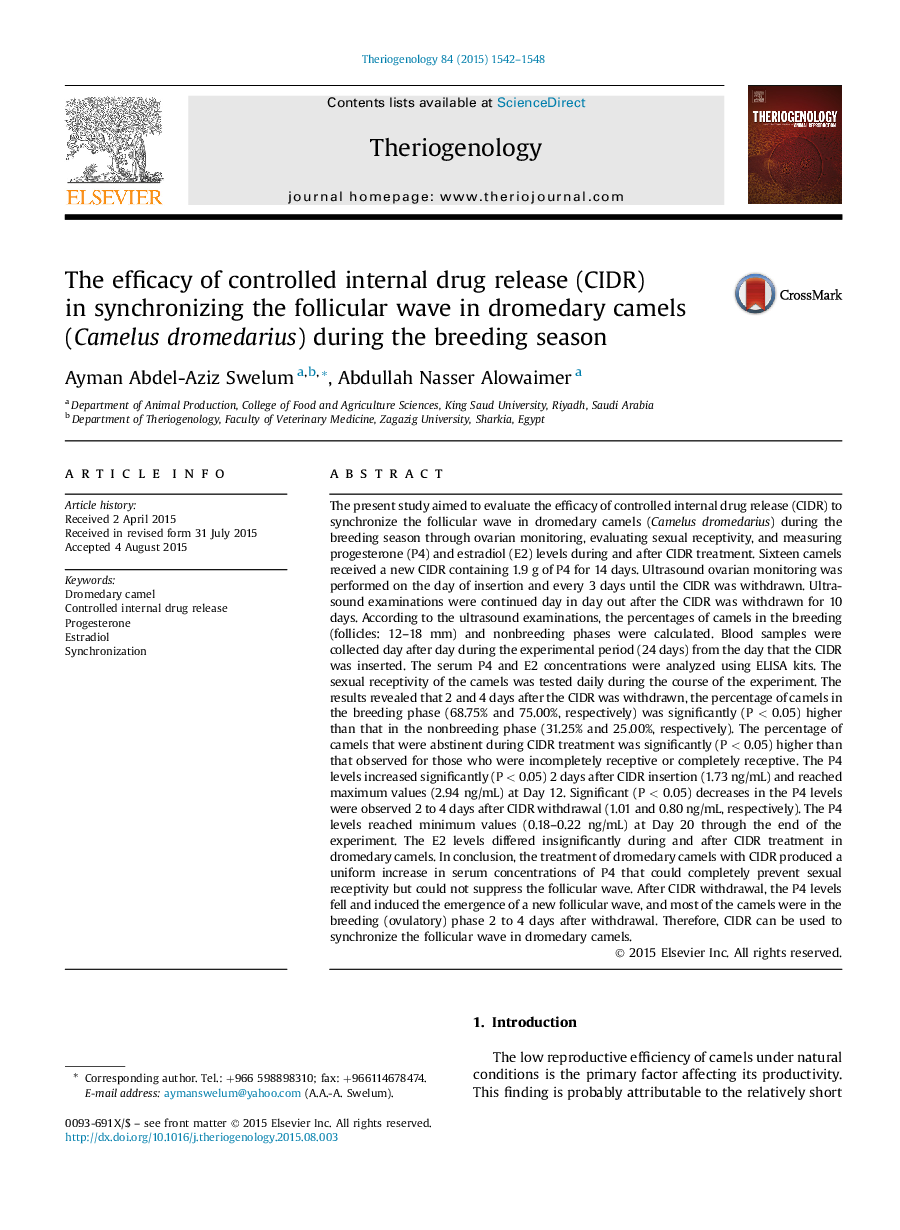| کد مقاله | کد نشریه | سال انتشار | مقاله انگلیسی | نسخه تمام متن |
|---|---|---|---|---|
| 2095767 | 1082137 | 2015 | 7 صفحه PDF | دانلود رایگان |
عنوان انگلیسی مقاله ISI
The efficacy of controlled internal drug release (CIDR) in synchronizing the follicular wave in dromedary camels (Camelus dromedarius) during the breeding season
دانلود مقاله + سفارش ترجمه
دانلود مقاله ISI انگلیسی
رایگان برای ایرانیان
کلمات کلیدی
موضوعات مرتبط
علوم زیستی و بیوفناوری
علوم کشاورزی و بیولوژیک
علوم دامی و جانورشناسی
پیش نمایش صفحه اول مقاله

چکیده انگلیسی
The present study aimed to evaluate the efficacy of controlled internal drug release (CIDR) to synchronize the follicular wave in dromedary camels (Camelus dromedarius) during the breeding season through ovarian monitoring, evaluating sexual receptivity, and measuring progesterone (P4) and estradiol (E2) levels during and after CIDR treatment. Sixteen camels received a new CIDR containing 1.9Â g of P4 for 14Â days. Ultrasound ovarian monitoring was performed on the day of insertion and every 3Â days until the CIDR was withdrawn. Ultrasound examinations were continued day in day out after the CIDR was withdrawn for 10 days. According to the ultrasound examinations, the percentages of camels in the breeding (follicles: 12-18Â mm) and nonbreeding phases were calculated. Blood samples were collected day after day during the experimental period (24Â days) from the day that the CIDR was inserted. The serum P4 and E2 concentrations were analyzed using ELISA kits. The sexual receptivity of the camels was tested daily during the course of the experiment. The results revealed that 2 and 4Â days after the CIDR was withdrawn, the percentage of camels in the breeding phase (68.75% and 75.00%, respectively) was significantly (PÂ <Â 0.05) higher than that in the nonbreeding phase (31.25% and 25.00%, respectively). The percentage of camels that were abstinent during CIDR treatment was significantly (PÂ <Â 0.05) higher than that observed for those who were incompletely receptive or completely receptive. The P4 levels increased significantly (PÂ <Â 0.05) 2Â days after CIDR insertion (1.73Â ng/mL) and reached maximum values (2.94Â ng/mL) at Day 12. Significant (PÂ <Â 0.05) decreases in the P4 levels were observed 2 to 4Â days after CIDR withdrawal (1.01 and 0.80Â ng/mL, respectively). The P4 levels reached minimum values (0.18-0.22Â ng/mL) at Day 20 through the end of the experiment. The E2 levels differed insignificantly during and after CIDR treatment in dromedary camels. In conclusion, the treatment of dromedary camels with CIDR produced a uniform increase in serum concentrations of P4 that could completely prevent sexual receptivity but could not suppress the follicular wave. After CIDR withdrawal, the P4 levels fell and induced the emergence of a new follicular wave, and most of the camels were in the breeding (ovulatory) phase 2 to 4Â days after withdrawal. Therefore, CIDR can be used to synchronize the follicular wave in dromedary camels.
ناشر
Database: Elsevier - ScienceDirect (ساینس دایرکت)
Journal: Theriogenology - Volume 84, Issue 9, December 2015, Pages 1542-1548
Journal: Theriogenology - Volume 84, Issue 9, December 2015, Pages 1542-1548
نویسندگان
Ayman Abdel-Aziz Swelum, Abdullah Nasser Alowaimer,